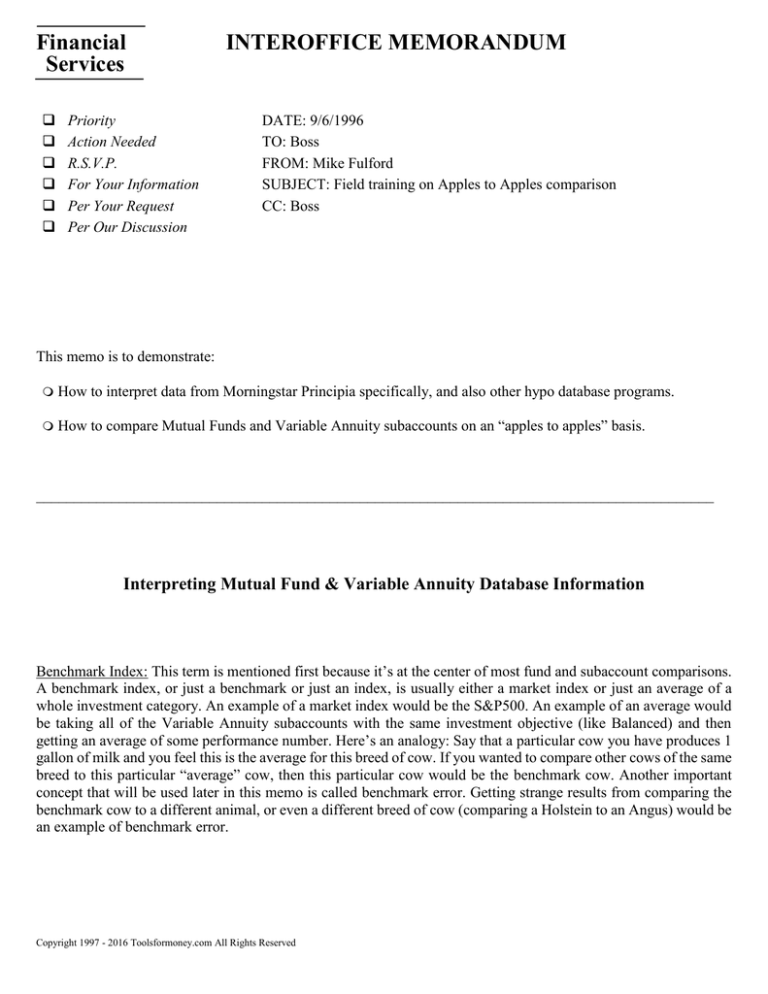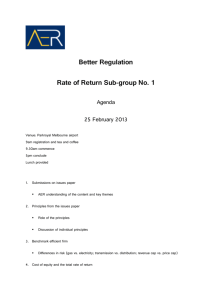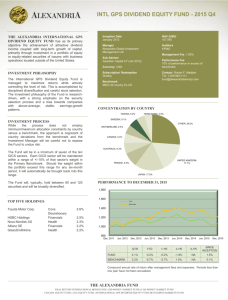
Financial
Services
Priority
Action Needed
R.S.V.P.
For Your Information
Per Your Request
Per Our Discussion
INTEROFFICE MEMORANDUM
DATE: 9/6/1996
TO: Boss
FROM: Mike Fulford
SUBJECT: Field training on Apples to Apples comparison
CC: Boss
This memo is to demonstrate:
How to interpret data from Morningstar Principia specifically, and also other hypo database programs.
How to compare Mutual Funds and Variable Annuity subaccounts on an “apples to apples” basis.
__________________________________________________________________________________________
Interpreting Mutual Fund & Variable Annuity Database Information
Benchmark Index: This term is mentioned first because it’s at the center of most fund and subaccount comparisons.
A benchmark index, or just a benchmark or just an index, is usually either a market index or just an average of a
whole investment category. An example of a market index would be the S&P500. An example of an average would
be taking all of the Variable Annuity subaccounts with the same investment objective (like Balanced) and then
getting an average of some performance number. Here’s an analogy: Say that a particular cow you have produces 1
gallon of milk and you feel this is the average for this breed of cow. If you wanted to compare other cows of the same
breed to this particular “average” cow, then this particular cow would be the benchmark cow. Another important
concept that will be used later in this memo is called benchmark error. Getting strange results from comparing the
benchmark cow to a different animal, or even a different breed of cow (comparing a Holstein to an Angus) would be
an example of benchmark error.
Copyright 1997 - 2016 Toolsformoney.com All Rights Reserved
Total return: 1 month, 3 month, 12 month, 3 year, 5 year, 10 year, and 15 year time frame. Most publishers
calculate ROR (rate of return) over a given time frame using this formula:
T
Ending NAV - Beginning NAV - 12b-1 - Management fees + Reinvested dividends and capital gains -1
Beginning NAV
Where the exponent, T, is the time period. For 1 year, T would be 1; for 10 years T would be 10, and for 3 months T
would be 0.25. All time periods (12 month to 15 years) are annual compounded RORs from the time of the latest
software update (currently 3/31/96), back in time. So a 12 month ROR is from 3/31/95 to 3/31/96, 1 month is from
3/1/96 to 3/31/96, and so on. Time periods less than 1 year are not raised to the power of T because they’re not an
annual compounded ROR (it’s just the ROR in that time period).
% Rank in Objective: This is an apples to apples comparison. The fund is compared to all other funds with the
same investment objective and ranked as to where its performance fell in that time period. The best fund in its
objective category would be #1.
Specific Year Annual Returns (E.G.- The ROR for 1994): This is just what it says and uses the formula given above.
Morningstar Ratings: This is too long of a story to list here, but you can look these up in their manuals. It’s their way
of rating funds given their criteria, which changes every once in a while. It basically calculates performance using the
risk free ROR (RF). It’s complicated, and most of the time it’s not an apples to apples comparison because of the
reasons given in the next section.
Sharpe Ratio: This is complex too, but it’s apples to apples so it is useful. This is a measure of an investment’s “risk
premium per unit of total risk.” Because it uses (standard deviation) instead of (Beta), it measures both total
return and diversification. For comparison purposes, all you really need to know is that higher numbers are better.
Higher numbers mean a more “efficient” portfolio. Don’t put too much weight in it because it’s just a gross measure
of relative performance.
The following are called “Modern Portfolio Statistics”, and ARE NOT apples to apples
comparisons using Principia (you need Principia Plus to do apples and apples):
R2: I’m using this stat first because it’s at the root of most problems in making investment comparisons. R 2 is a
statistic used in regression analysis. Regression analysis is used to compare the variation in one thing to that of
another for the purpose of trying to predict how one thing will react to changes in the other thing. Its long name is the
“coefficient of determination” because its purpose is to determine the relationship between things.
The problem with R2 in Principia is that the benchmark used for funds/subaccounts that are equity-like is the only
the S&P 500. For anything bond-like, it’s only the Lehman Aggregate Bond Index. In order to get valid R2 numbers
for funds and subaccounts, you need to compare the fund/subaccount to its investment objective index. In order to do
this, you to have the Principia Plus program.
The heart of the investment apples to apples vs. apples to oranges debate is what benchmark is used in making
comparisons. Let’s look at an investment objective that’s not really similar to the S&P500- Equity Income. An
Equity Income fund is an unweighted fund consisting of about 100 large stocks in the mature growth phase of its life
cycle. About 60% is in U.S. stocks and the remainder is in international stocks, bonds, and cash. The S&P500 is a
totally different animal because it’s a market cap weighted average of 500 large firms that most resemble the U.S.
economy. There are no bonds in the S&P500, no cash, no international securities, and these 500 firms could be
Copyright 1997 - 2016 Toolsformoney.com All Rights Reserved
anywhere in their life cycles (which determines dividend payout policy- Equity Income funds purchase stocks with a
high dividend payout history). A typical Principia R2 for an Equity Income fund is about 0.85. This means that about
85% of the variation in the Equity Income fund can be explained by variation in the S&P500. This is way too low to
make meaningful comparisons, so a different benchmark should be used. For the Equity Income objective, the
correct benchmark is just the average of all the Equity Income funds/subaccounts in the database. You won’t be able
to use the proper benchmark with funds or subaccounts using Principia because you’re stuck with the S&P500 for
equity-like investments.
Now let’s look at the investment objectives that most closely match the S&P500- Growth and Growth and Income.
I used Principia to sort through all of the 3,709 equity funds to find the funds that had an R2 of more than 0.92, and
were not index funds (the printout is in the back of this report). There were 29 funds; 19 were Growth & Income, and
10 were Growth funds. The only fund that we can sell in this list is American Funds Investment Company of America
(Growth & Income). It has an R2 of 0.95. This fund has 9% in cash, 9.2% in international stocks, and 5.3% in bonds.
Only 76.5% of this fund is in U.S. stocks, so comparing this fund to to the S&P500 is an apples to oranges
comparison. A Growth & Income index should be used instead, and you need Principia Plus to do that.
Here is all you need to know about R2 (unless you have a program that can do R2 right in the first place): R2 values
range from 0 to 1 (Principia lists them as 0-100. That’s not mathematically correct, but we don’t care because we’re
not mathematicians). 0.0 means that absolutely none of the variance in the thing you’re comparing is related (or
explained by) to the benchmark you’re comparing it to. An R2 of 1.0 means that 100% of the variation of what you’re
interested in is explained by the variation in the benchmark.
What does all of this mean in your everyday life? If you’re using Morningstar Principia, and the fund/subaccount
you’re interested in has an R2 of less than 0.95, then you’re comparing apples to oranges, and you can ignore the next
2 stats completely (Alpha and Beta).
Beta: is used to compare the risk (systematic variation or market risk) of an asset to the same risk of a benchmark
index. The purpose of this is to help predict what will happen to the value of the asset in response to fluctuations in
the value of the benchmark. Again, the only 2 benchmarks used for funds in Principia are the S&P 500 and the
Lehman Aggregate Bond Index. So if the R2 value of the fund/subaccount is lower than 0.95, then you’re comparing
apples to oranges, and is mostly meaningless.
Alpha: is used as an indication of how an asset has performed in the past relative to a benchmark index. Using the
CAPM formula (Capital Asset Pricing Model- if this is new to you, don’t worry about it), an investment’s
performance can be “predicted.” If the asset’s performance is more than what the CAPM predicted, then the asset has
a “positive .” For example, if the CAPM predicted an asset to have a total return of 10% (using the S&P500 as the
benchmark in one of the factors in the formula), and its total return was actually 11%, then its is 1. If the actual was
9%, is then -1.0. The same caveats go with as with : if R2 is less than 0.95, then you’re comparing apples to
oranges, and the comparison is mostly meaningless with Principia.
Comparing Fund/Subaccounts on an Apples to Apples Basis
Benchmark errors exist when an investment performance comparison is made using dissimilar benchmarks or
indices. An analogy would be saying that since a goat only produces a quart of milk, and the cow puts out a gallon,
the goat is useless compared to the cow. The point is that the goat and the cow are two totally different animals and
thus should not be compared solely on the basis of milk production.
The first step in making valid fund/subaccount comparisons is to use the correct benchmark index. You won’t be able
to do this with Principia or most other hypo software for mutual funds. Once the correct benchmark index is used, the
next step is to adjust the benchmark/index for all loads, 12b-1 changes, management fees, and M&E expenses. This
is needed because the benchmark/index does not have loads, fees, or other expenses. You just
Copyright 1997 - 2016 Toolsformoney.com All Rights Reserved
subtract these expenses from the ROR of the benchmark index.
For example, if you wanted to compare the AUL VA American Bond subaccount to the correct benchmark, the
VA Corporate Bond index, you need to take the index’s ROR and then subtract 1.95% (the total expenses from the
actual subaccount).
The following charts show the differences in comparing apples to oranges vs. apples to apples. The first chart shows
benchmark errors combined with the error from not adjusting for expenses. The next 3 use the correct benchmarks,
and are adjusted for expenses which gives a true apples to apples comparison.
This 1 year time frame was 1/1/95 to 1/31/96 due to a software idiosyncrasy.
VA Subaccount Name
Improper Benchmark Used
Alger American Growth
AUL American Bond
American Money Market
American Managed Portfolio
AUL American Equity
Calvert Capital Accumulation
Fidelity Growth Portfolio
Fidelity Asset Manager
Fidelity Equity Income
Fidelity High Income
Fidelity VIP II Index 500
Fidelity Overseas Portfolio
Fidelity Contrafund
INVESCO Dynamics
PBHG Growth
20th Century TCI Growth
20th Century Select
20th Century Ultra
20th Century Int’l Equity
T. Rowe Price Equity Income
Vangrd: Short Term Fed Bond
Vanguard Explorer
S&P 500
Lehman Aggregate Bonds
Lehman Aggregate Bonds
S&P 500
S&P 500
S&P 500
S&P 500
S&P 500
S&P 500
Lehman Aggregate Bonds
S&P 500 (OK)
S&P 500
S&P 500
S&P 500
S&P 500
S&P 500
S&P 500
S&P 500
S&P 500
S&P 500
Lehman Aggregate Bonds
S&P 500
Copyright 1997 - 2016 Toolsformoney.com All Rights Reserved
Benchmark
ROR
36.67%
12.61%
12.61%
36.67%
36.67%
36.67%
36.67%
36.67%
36.67%
12.61%
36.67%
36.67%
36.67%
36.67%
36.67%
36.67%
36.67%
36.67%
36.67%
36.67%
12.61%
36.67%
1 Year
Sub-Account
ROR
42.57%
12.67%
3.92%
16.43%
19.46%
30.65%
38.09%
17.72%
31.91%
19.48%
34.55%
15.21%
39.32%
38.71%
52.33%
25.22%
26.55%
42.97%
20.65%
31.37%
10.30%
26.86%
1 Year
Delta
+5.90%
+0.06%
-8.69%
-20.24%
-15.68%
-1.42%
+1.42%
-18.95%
+4.76%
+6.87%
-2.12%
-21.46%
+2.65
+2.04
15.66
-11.45%
-10.12%
+6.3%
-16.02%
-5.3%
-2.31%
-9.81%
THE FOLLOWING CHARTS ARE APPLES TO APPLES USING THE CORRECT BENCHMARKS:
All benchmarks are Variable Annuity (VA) indexes complied by CDA Weisenberger, Inc.
VA Subaccount Name
Proper Benchmark Used
Alger American Growth
AUL American Bond
AUL American Money Market
American Managed Portfolio
AUL American Equity
Calvert Capital Accumulation
Fidelity Growth Portfolio
Fidelity Asset Manager
Fidelity Equity Income
Fidelity High Income Portfolio
Fidelity VIP II Index 500
Fidelity Overseas Portfolio
Fidelity Contrafund
INVESCO Dynamics
PBHG Growth
20th Century TCI Growth
20th Century Select
20th Century Ultra
20th Century Int’l Equity
T. Rowe Price Equity Income
Vangrd: Short Term Fed Bond
Vanguard Explorer
VA- Long Term Growth
VA- Corporate Bond
VA- Money Market
VA- Balanced
VA- Long Term Growth
VA- Small Company Growth
VA- Long Term Growth
VA- Asset Allocation
VA- Equity Income
VA- Corporate High Yield
S&P 500 Composite
VA- International Equity
VA- Long Term Growth
VA- Small Company Growth
VA- Small Company Growth
VA- International Equity
VA- Long Term Growth
VA- Small Company Growth
VA- International Equity
VA- Equity Income
VA- Gov Securities (Closest)
VA- Small Company Growth
Copyright 1997 - 2016 Toolsformoney.com All Rights Reserved
Benchmark
ROR
30.19%
11.05%
2.28%
19.75%
30.19%
27.21%
30.19%
19.35%
28.44%
15.56%
35.12%
16.31%
30.19%
27.21%
27.21%
16.31%
30.19%
27.21%
16.31%
28.44%
13.27
27.21%
1 Year
Sub-Account
ROR
42.57%
12.67%
3.92%
16.43%
19.46%
30.65%
38.09%
17.72%
31.91%
19.48%
34.55%
15.21%
39.32%
38.71%
52.33%
25.22%
26.55%
42.97%
20.65%
31.37%
10.30%
26.86%
1 Year
Delta
+12.38%
-1.62%
+1.64%
-3.32%
-10.73%
+3.44%
+7.90%
-1.63%
+3.47%
+3.92%
-.057%
-1.10%
+9.13%
+11.50%
+25.12%
+8.91%
-3.64%
+15.76%
+4.34%
+2.93%
-2.97%
-0.35%
3 Year Period: 1/1/93 to 12/31/95
VA Subaccount Name
Proper Benchmark Used
Alger American Growth
AUL American Bond
AUL American Money Market
American Managed Portfolio
AUL American Equity
Calvert Capital Accumulation
Fidelity Growth Portfolio
Fidelity Asset Manager
Fidelity Equity Income
Fidelity High Income Portfolio
Fidelity VIP II Index 500
Fidelity Overseas Portfolio
INVESCO Dynamics
PBHG Growth
20th Century TCI Growth
20th Century Select
20th Century Ultra
20th Century Int’l Equity
Vangrd: Short Term Fed Bond
Vanguard Explorer
VA- Long Term Growth
VA- Corporate Bond
VA- Money Market
VA- Balanced
VA- Long Term Growth
VA- Small Company Growth
VA- Long Term Growth
VA- Asset Allocation
VA- Equity Income
VA- Corporate High Yield
S&P 500 Composite
VA- International Equity
VA- Small Company Growth
VA- Small Company Growth
VA- Long Term Growth
VA- Long Term Growth
VA- Small Company Growth
VA- International Equity
VA- Gov Securities (Closest)
VA- Small Company Growth
Benchmark
ROR
10.69%
3.24%
2.79%
6.35%
10.69%
11.99%
10.69%
6.21%
11.29%
6.16%
12.74%
8.13%
11.99%
11.99%
10.69%
10.69%
11.99%
8.13%
5.75%
11.99%
3 Year
Sub-Account
ROR
17.75%
6.59%
2.42%
8.70%
10.67%
9.20%
15.88%
8.64%
18.13%
11.25%
12.57%
13.86%
15.62%
30.58%
10.49%
7.69%
15.98%
13.52%
4.43%
12.27%
3 Year
Delta
+7.06%
+3.35%
-0.37%
+2.35%
-0.02%
-2.79%
+5.19%
+2.43%
+6.84%
+5.09%
-0.17%
+5.73%
+3.63%
+18.59%
-0.20%
-3.00%
+3.99%
+5.39%
-1.32%
+0.28%
5 Year Period: 1/1/90 to 12/31/95
VA Subaccount Name
Proper Benchmark Used
Alger American Growth
AUL American Bond
AUL American Money Market
American Managed Portfolio
AUL American Equity
Fidelity Growth Portfolio
Fidelity Asset Manager
Fidelity Equity Income
Fidelity High Income Portfolio
Fidelity Overseas Portfolio
INVESCO Dynamics
PBHG Growth
20th Century TCI Growth
20th Century Select
20th Century Ultra
Vangrd: Short Term Fed Bond
Vanguard Explorer
VA- Long Term Growth
VA- Corporate Bond
VA- Money Market
VA- Balanced
VA- Long Term Growth
VA- Long Term Growth
VA- Asset Allocation
VA- Equity Income
VA- Corporate High Yield
VA- International Equity
VA- Small Company Growth
VA- Small Company Growth
VA- Long Term Growth
VA- Long Term Growth
VA- Small Company Growth
VA- Gov Securities (Closest)
VA- Small Company Growth
Copyright 1997 - 2016 Toolsformoney.com All Rights Reserved
Benchmark
ROR
12.15%
6.86%
2.61%
10.36%
12.15%
12.15%
9.04%
13.56%
12.38%
7.37%
12.90%
12.90%
12.15%
12.15%
12.90%
4.80%
12.90%
5 Year
Sub-Account
ROR
20.24%
8.06%
2.67%
9.56%
12.81%
19.28%
11.36%
19.83%
17.46%
6.78%
23.31%
33.43%
10.07%
8.90%
23.52%
5.78%
19.46%
5 Year
Delta
+8.09%
+1.20%
+0.06%
-0.80%
+0.66%
+7.13%
+2.32%
+6.27%
+5.08%
-0.59%
+10.41%
+20.53%
-2.08%
-3.25%
+10.62%
+0.98%
+6.56%






